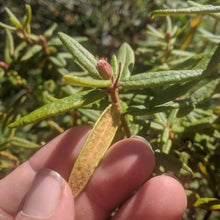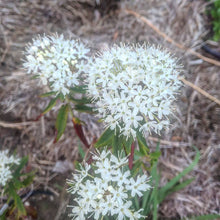Bog Labrador Tea
Regular price
$4.50
Sale
Ledum groenlandicum (or Rhododendron groenlandicum)
Origin: New Jersey
Improvement Status: Cultivated wild material
Seeds per packet: ~35
BOTANICAL SAMPLE - NOT GERMINATION TESTED
Life cycle: Perennial
Bog Labrador Tea is a beautiful perennial shrub very closely related to rhododendrons (some sources now classify it as a species of rhododendron). It has very small white flowers and azalea-like leaves with downturned edges creating a space underneath each leaf filled with a delicate orange fuzz. The dried leaves have long been used to make tea, noted for its mildly sedative effect and as a cure for winter colds. Indigenous peoples are said to have used it this way, as well as using it as a flavoring for meat. Commonly found in bogs and peatlands in boreal forests, its range extends across Canada and well into the northern reaches of the United States, including Washington and Oregon, the upper Midwest, and New England, with a few disjunct populations in Ohio, Pennsylvania, New York, and New Jersey (though the main population in NJ was destroyed decades ago to build the Short Hills Mall). It is rarely available in the nursery trade, but can sometimes be found and used as a landscape plant. Provided acidic soil and enough water, it can survive far from any bogs or peatlands.
Two other species are also referred to as Labrador Tea, but both contain higher levels of a terpenoid toxin called "ledol," which is also found in Bog Labrador Tea. One species was apparently used to induce visions in shamanistic rituals among traditional people of the Caucusus region. This toxin can cause cramps, delerium, and even paralysis (or possibly death), but it is also found in many plants that are nevertheless regularly consumed by humans, including cloves, hops, hyssop, peppermint, American ginseng, and common garden sage. While Bog Labrador Tea has a long history of use, we recommend using caution with it, especially when ingesting for the first time. It is very important that when making tea you DO NOT boil the leaves, but merely steep them in hot water, as boiling releases additional toxic alkaloids. You should also keep it away from livestock, as there have been documented cases of livestock poisoning.
All that said, Bog Labrador Tea is a beautiful and magical plant that is well worth a try. It is also quite sensitive to environmental changes, so it may be an early casualty to global warming, which means growing as much of it from seed and attempting to adapt it to warmer regions of the country is a worthwhile goal. It is easy to start from seed, surface-sowing on a bottom-watered, constantly-moist peat moss growing medium and kept in a relatively cool but intermittently sunny spot. The plants are slow growing, so they remain quite small their first year, but they are really quite adorable, and they should reach maturity within a few years. The seeds — incredibly thin, short, and fiber-like — are practically invisible. Our seed stock this year comes from a wild population in central Minnesota.
Our seed was imported from Canada by the good folks at Sheffield's Seed Company in Locke, NY.
GROWING TIPS: Labrador Tea is surprisingly easy to start from seed, using a bottom-watered, constantly-moist peat moss growing medium and kept in a relatively cool but intermittently sunny spot. The plants are slow-growing, so they remain quite small their first year, but they are really quite adorable, and they should reach maturity within a few years. The seeds — incredibly thin, short, and fiber-like — are practically invisible.
NOTE: As these seeds are very hard to come by, take some time to germinate, and need very specific growing conditions to sprout, we are not germination testing them but instead offering them as a botanical sample. They were collected fresh in the fall of 2020, in the same way as we collected seeds in 2018 which we grew successfully the following year, so we have every expectation that they will grow for you.




